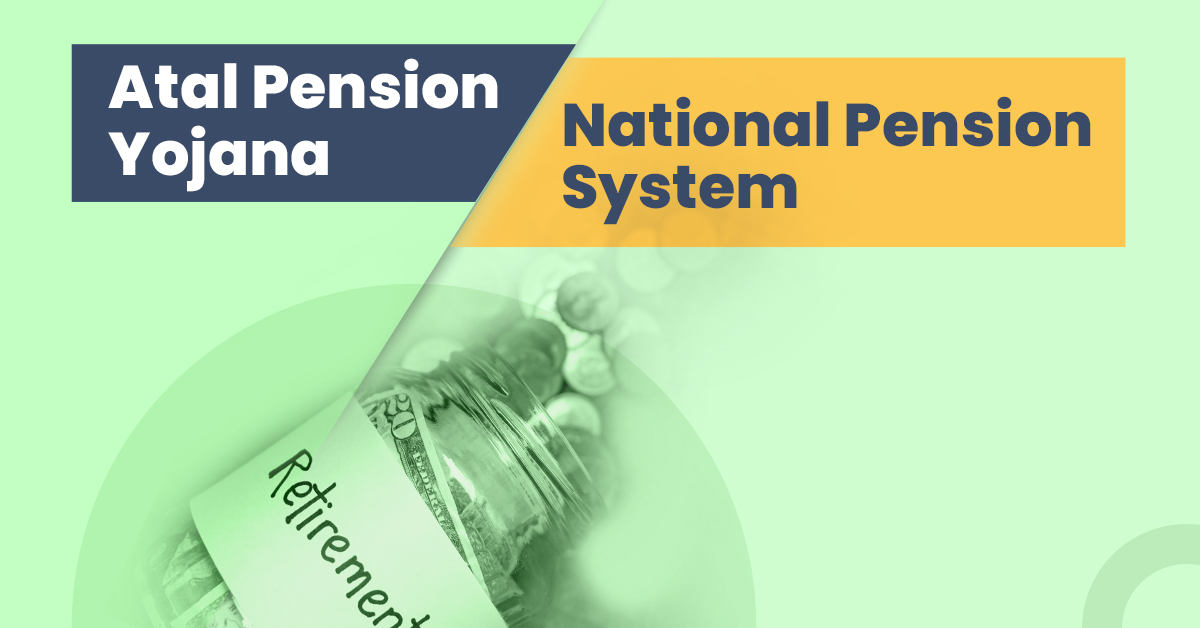Atal Pension Yojana vs NPS: A Comparative Guide


Post-retirement days are when you don’t have an active work life, and your income shrinks. However, even then, you have certain basic expenses, including medical costs. To ensure that you have a financially stable life when you have grown senile, you need to start saving from the very beginning of your working life.
There are several government-backed investment schemes to help you create a retirement corpus. Atal Pension Yojana and National Pension Scheme are two such pension schemes under the government’s jurisdiction. However, before investing in any of them, you must thoroughly know both. Moreover, since both are pension schemes, you might wonder: Atal Pension Yojana Vs Nps – which is better?
To decide which method suits your financial needs, you need to know the similarities and differences between Atal Pension Yojana and NPS. The following article aims to give a detailed explanation regarding the same so that you can choose the perfect scheme.
Note: Income taxpayers are not eligible to register for APY (Atal Pension Yojana) w.e.f. October 1, 2022.
Also Read: Section 80CCD: Deductions For NPS And APY Contributions
What is the NPS Scheme?
The National Pension Scheme was launched on 1st January 2004. It is a national social security initiative by the Indian government to inculcate the habit of savings among salaried employees.
Initially, this scheme was meant only for government employees, except armed forces personnel. But this scheme was revised on 1st May 2009 and made available for all citizens of the country, on a voluntary basis, including the unorganised sector. Under this scheme, the contribution made by the subscribers is invested in market-linked instruments such as debt and equity. Hence, the returns are dependent on the performance of these instruments.
The scheme will mature when you turn 60. You may then withdraw 60% of your accumulated amount. The remaining 40% must be kept aside to receive a regular annuity.
Also Read: Atal pension yojana tax benefits
What is the APY Scheme?
Note: Income taxpayers are not eligible to register for APY (Atal Pension Yojana) w.e.f. October 1, 2022.
The Atal Pension Yojana scheme, administered by the Pension Fund Regulatory and Development Authority, was launched in the 2015-16 financial year; hence, it is relatively new compared to NPS.
This scheme was implemented to safeguard the retirement interests of people working in the unorganised sector. It provides a guaranteed pension amount ranging from Rs. 1,000 to Rs. 5,000, depending on the contribution amount. However, you will start receiving your pension after you reach 60.
Also Read: What is the Eligibility for Atal Pension Yojana?
Difference Between Atal Pension Yojana and National Pension Scheme
Now, you might be wondering, NPS vs APY – which one is better? A table highlighting the differences between NPS and APY has been given below to make the decision easy.
| Factors | Atal Pension Yojana(APY) | National Pension Scheme(NPS) |
| Joining Age | Any individual between 18 and 40 can open an APY account. | Anyone between 18-60 years can subscribe to NPS. |
| Eligibility Criteria | The subscriber should be an Indian resident. Income taxpayers are no longer eligible to register for APY w.e.f. October 1, 2022. | Both an Indian Resident and a Non-Resident of India (NRI) are eligible for NPS. |
| Account Type | One account type only. | NPS scheme has two account types: Tier-I and Tier-II. |
| Nomination | You need to select a nominee for your APY account mandatorily. Subscribers who are married will have their spouse as their default nominee, while subscribers who are unmarried can nominate anyone else. | When opening an NPS account, you must appoint a nominee in the prescribed section. Your NPS account can contain up to three nominees. |
| Pension Slab | The beneficiary will receive a fixed amount of pension each month. The pension amount ranges from Rs. 1,000 to Rs. 5,000. | Under the NPS, there is no fixed pension slab, as the returns are subject to fluctuations in the money market. |
| Guaranteed Returns | The APY scheme yields a guaranteed pension amount to the beneficiary after retirement. | This scheme does not guarantee a fixed return as it is linked to capital markets. |
| Premature Withdrawal | Premature withdrawal is not encouraged before you cover the maturity period. However, in cases of a medical emergency or your untimely demise, the deposited amount plus the interest accrued can be withdrawn. Other than these two instances, you can withdraw your deposited amount, but you will have to surrender the interest accrued. | Partial withdrawal is allowed in NPS, subject to certain conditions. In the case of a Tier-II account, you can remove prematurely only from the third year of investment under exceptional circumstances such as medical emergencies, higher education of children, marriage, or purchase of a home(in specified conditions). You can make a partial withdrawal of up to 25% of the balance in your Tier I account. |
| Investment Choice | No investment choice is provided to an APY scheme subscriber. | An NPS beneficiary can choose from active and auto investment options. Further, they can also opt for a fund manager to manage the funds. |
| Account Number | A Permanent Retirement Account Number is given to the APY beneficiary. | A Permanent Retirement Account Number is also given to the NPS beneficiary. |
| Government Contribution | The government contributes a certain amount of money to the APY account of each subscriber to encourage more people to enrol in this scheme and expand its reach. The contribution amount is subject to specific terms and conditions. | The government does not donate any funds to the NPS account. |
Similarities between APY and NPS
A comparison between APY and NPS reveals that, though there are differences between APY and NPS, these two schemes have a few similarities too:
- APY and NPS are retirement-oriented investment plans which can help you save a good deal of money for your post-retirement days.
- Both of them are pension schemes.
- The PFRDA, or Pension Fund Regulatory and Development Authority, regulates both plans.
- The contributions to the schemes are subject to a tax deduction of a maximum amount of Rs. 1.5 lakhs, under Section 80 CCD (1). Furthermore, you can claim an additional tax deduction under Section 80 CCD (1B) for contributions made up to Rs. 50,000. This tax benefit is available for both schemes.
- The pension received under these schemes is taxable per your income tax slab rate.
Also Read: Everything You Should Know about Atal Pension Yojana Age Limit
Final Thoughts
How often have you heard the proverb – ‘Make hay while the sun shines?’ To turn this proverb into a reality in your life, you must prepare yourself for your post-retirement days while you are still strong and working.
Both APY and NPS are pension schemes which ensure a fixed income for the post-retirement days for people working in both organised and unorganised sectors. If your query has been NPS vs Atal Pension Yojana – which is better? This article might have given you a clear idea of the similarities and differences between these two schemes.
FAQs
Do I need to pay a fine if I discontinue contributions to the National Pension System and Atal Pension Yojana?
Yes, you need to pay a fixed penalty under both schemes if you stop your contribution. If you fail to contribute to your Atal Pension Scheme account, you will have to pay a monthly fine ranging from Rs. 1 to Rs. 12. The penalty is determined based on your monthly contribution.
If you do not make the minimum contribution to your NPS account, your account will be frozen and you will have to pay a fine of Rs. 100.
Can an individual choose to invest in both NPS and APY schemes?
Yes, you can invest in both NPS and APY; however, you have to fulfil the eligibility criteria of the respective schemes.
Can a lump sum investment be made in NPS and APY schemes?
Under NPS, you can contribute a lump sum. However, lump sum contribution is not allowed under the Atal Yojana Scheme. You have to invest either monthly, quarterly, or half-yearly.
How many accounts can an individual open under APY and NPS schemes?
An individual can open only one account under Atal Pension Yojana and the National Pension Scheme.
Can I open an APY account without having a savings bank account?
No, you cannot open an Atal Pension Yojana account without a savings bank account.
Will I receive a transaction statement under the National Pension Scheme and the Atal Pension Yojana?
Yes, you will receive a detailed transaction statement under both schemes for any transaction you make.
What is the minimum contribution to NPS?
You need to deposit a minimum of Rs. 500 for the Tier I NPS account, and for the Tier II NPS account, you need to pay at least Rs. 1,000.



